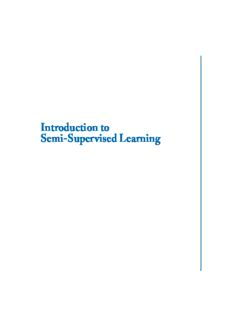
Introduction to Semi-supervised Learning (Synthesis Lectures on Artificial Intelligence and Machine Learning) PDF
Preview Introduction to Semi-supervised Learning (Synthesis Lectures on Artificial Intelligence and Machine Learning)
Introduction to Semi-Supervised Learning Synthesis Lectures on Artificial Intelligence and Machine Learning Editors RonaldJ.Brachman,Yahoo!Research ThomasDietterich,OregonStateUniversity IntroductiontoSemi-SupervisedLearning XiaojinZhuandAndrewB.Goldberg 2009 ActionProgrammingLanguages MichaelThielscher 2008 RepresentationDiscoveryusingHarmonicAnalysis SridharMahadevan 2008 EssentialsofGameTheory:AConciseMultidisciplinaryIntroduction KevinLeyton-Brown,YoavShoham 2008 AConciseIntroductiontoMultiagentSystemsandDistributedArtificialIntelligence NikosVlassis 2007 IntelligentAutonomousRobotics:ARobotSoccerCaseStudy PeterStone 2007 Copyright© 2009byMorgan&Claypool Allrightsreserved.Nopartofthispublicationmaybereproduced,storedinaretrievalsystem,ortransmittedin anyformorbyanymeans—electronic,mechanical,photocopy,recording,oranyotherexceptforbriefquotationsin printedreviews,withoutthepriorpermissionofthepublisher. IntroductiontoSemi-SupervisedLearning XiaojinZhuandAndrewB.Goldberg www.morganclaypool.com ISBN:9781598295474 paperback ISBN:9781598295481 ebook DOI10.2200/S00196ED1V01Y200906AIM006 APublicationintheMorgan&ClaypoolPublishersseries SYNTHESISLECTURESONARTIFICIALINTELLIGENCEANDMACHINELEARNING Lecture#6 SeriesEditors:RonaldJ.Brachman,Yahoo!Research ThomasDietterich,OregonStateUniversity SeriesISSN SynthesisLecturesonArtificialIntelligenceandMachineLearning Print1939-4608 Electronic1939-4616 Introduction to Semi-Supervised Learning Xiaojin Zhu and Andrew B.Goldberg UniversityofWisconsin,Madison SYNTHESISLECTURESONARTIFICIALINTELLIGENCEAND MACHINELEARNING#6 M &C Morgan &cLaypool publishers ABSTRACT Semi-supervised learning is a learning paradigm concerned with the study of how computers and naturalsystemssuchashumanslearninthepresenceofbothlabeledandunlabeleddata.Traditionally, learning has been studied either in the unsupervised paradigm (e.g.,clustering,outlier detection) whereallthedataisunlabeled,orinthesupervisedparadigm(e.g.,classification,regression)where allthedataislabeled.Thegoalofsemi-supervisedlearningistounderstandhowcombininglabeled and unlabeled data may change the learning behavior,and design algorithms that take advantage of such a combination.Semi-supervised learning is of great interest in machine learning and data miningbecauseitcanusereadilyavailableunlabeleddatatoimprovesupervisedlearningtaskswhen thelabeleddataisscarceorexpensive.Semi-supervisedlearningalsoshowspotentialasaquantitative tool to understand human category learning,where most of the input is self-evidently unlabeled. In this introductory book, we present some popular semi-supervised learning models, including self-training,mixturemodels,co-trainingandmultiviewlearning,graph-basedmethods,andsemi- supervisedsupportvectormachines.Foreachmodel,wediscussitsbasicmathematicalformulation. The success of semi-supervised learning depends critically on some underlying assumptions. We emphasize the assumptions made by each model and give counterexamples when appropriate to demonstratethelimitationsofthedifferentmodels.Inaddition,wediscusssemi-supervisedlearning for cognitive psychology.Finally,we give a computational learning theoretic perspective on semi- supervised learning, and we conclude the book with a brief discussion of open questions in the field. KEYWORDS semi-supervisedlearning,transductivelearning,self-training,Gaussianmixturemodel, expectation maximization (EM), cluster-then-label, co-training, multiview learning, mincut,harmonicfunction,labelpropagation,manifoldregularization,semi-supervised supportvectormachines(S3VM),transductivesupportvectormachines(TSVM),en- tropyregularization,humansemi-supervisedlearning To our parents Yu and Jingquan Susan and Steven Goldberg with much love and gratitude. ix Contents Preface.........................................................................xiii 1 IntroductiontoStatisticalMachineLearning........................................1 1.1 TheData..................................................................2 1.2 UnsupervisedLearning......................................................2 1.3 SupervisedLearning........................................................3 2 OverviewofSemi-SupervisedLearning.............................................9 2.1 LearningfromBothLabeledandUnlabeledData..............................9 2.2 HowisSemi-SupervisedLearningPossible? .................................11 2.3 Inductivevs.TransductiveSemi-SupervisedLearning.........................12 2.4 Caveats...................................................................13 2.5 Self-TrainingModels......................................................15 3 MixtureModelsandEM.........................................................21 3.1 MixtureModelsforSupervisedClassification ................................21 3.2 MixtureModelsforSemi-SupervisedClassification...........................25 ∗ 3.3 OptimizationwiththeEMAlgorithm ......................................26 3.4 TheAssumptionsofMixtureModels........................................28 3.5 OtherIssuesinGenerativeModels..........................................30 3.6 Cluster-then-LabelMethods...............................................31 4 Co-Training.....................................................................35 4.1 TwoViewsofanInstance..................................................35 4.2 Co-Training ..............................................................36 4.3 TheAssumptionsofCo-Training...........................................37 ∗ 4.4 MultiviewLearning ......................................................38 x CONTENTS 5 Graph-BasedSemi-SupervisedLearning...........................................43 5.1 UnlabeledDataasSteppingStones..........................................43 5.2 TheGraph................................................................43 5.3 Mincut...................................................................45 5.4 HarmonicFunction........................................................47 ∗ 5.5 ManifoldRegularization ..................................................50 ∗ 5.6 TheAssumptionofGraph-BasedMethods .................................51 6 Semi-SupervisedSupportVectorMachines ........................................57 6.1 SupportVectorMachines ..................................................58 ∗ 6.2 Semi-SupervisedSupportVectorMachines .................................61 ∗ 6.3 EntropyRegularization ...................................................63 6.4 TheAssumptionofS3VMsandEntropyRegularization ......................65 7 HumanSemi-SupervisedLearning................................................69 7.1 FromMachineLearningtoCognitiveScience................................69 7.2 StudyOne:HumansLearnfromUnlabeledTestData.........................70 7.3 StudyTwo:PresenceofHumanSemi-SupervisedLearninginaSimpleTask....72 7.4 StudyThree:AbsenceofHumanSemi-SupervisedLearninginaComplexTask 75 7.5 Discussions...............................................................77 8 TheoryandOutlook.............................................................79 ∗ 8.1 ASimplePACBoundforSupervisedLearning ..............................79 ∗ 8.2 ASimplePACBoundforSemi-SupervisedLearning ........................81 8.3 FutureDirectionsofSemi-SupervisedLearning..............................83 A BasicMathematicalReference....................................................85 B Semi-SupervisedLearningSoftware...............................................89 C Symbols ........................................................................93 Biography ..................................................................... 113
